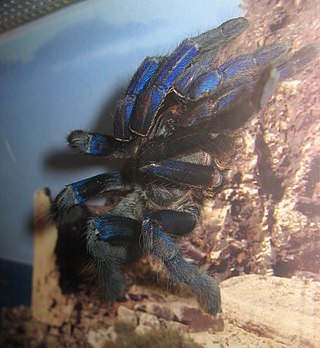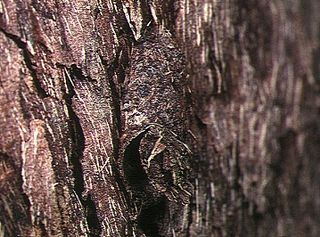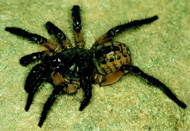
The spider family Liphistiidae was first recognized by Tamerlan Thorell in 1869. When narrowly circumscribed, it comprises a single genus Liphistius, native to Southeast Asia; as of April 2024, this was the circumscription accepted by the World Spider Catalog. The family contains the most basal living spiders, belonging to the suborder Mesothelae. The family has also been circumscribed more broadly to include the family Heptathelidae as a subfamily, Heptathelinae, with the narrowly circumscribed Liphistiidae becoming the subfamily Liphistiinae.

Heptathela is a genus of spiders that includes the Kimura spider. They are trapdoor spiders of the family Heptathelidae and are found in Japan, including Okinawa and the Ryukyu Islands. Spiders of this genus lack venom glands.

Ornithoctoninae is a subfamily of tarantulas found in Southeast Asia. It was first erected in 1895 by Reginald Innes Pocock based on the type specimen Ornithoctonus andersoni.

Stenochilidae is a family of southeast Asian araneomorph spiders that produce ecribellate silk. First described by Tamerlan Thorell in 1873, it now contains twelve described species in two genera.

Atypus, also called purseweb spiders, is a genus of atypical tarantulas first described by Pierre André Latreille in 1804. It occurs in Eurasia, with one species reaching into North Africa. Only three of the described species occur in Europe: A. piceus, A. affinis, and A. muralis. Specimens from the USA formerly known as A. snetsingeri represent an introduced population of A. karschi.
Pacullidae is a family of araneomorph spiders first described by Eugène Simon in 1894. It was merged into Tetrablemmidae in 1958, then raised back to family status after a large phylogenetic study in 2017.

Clubiona is a genus of sac spiders that was first described by Pierre André Latreille in 1804.

Cyclocosmia is a genus of mygalomorph trapdoor spiders in the family Halonoproctidae, first described by Anton Ausserer in 1871. Originally placed with the Ctenizidae, when the family split in 2018, this genus was placed with the Halonoproctidae as the type genus. The name is derived from the Greek "kyklos" (κυκλος), meaning "circle", and "kosmeo" (κοσμεω), meaning "to adorn".

Sinopoda is a genus of Asian huntsman spiders that was first described by Peter Jäger in 1999.

Mallinella is a genus of spider in the family Zodariidae.

Conothele is a genus of mygalomorph spiders in the family Halonoproctidae, first described by Tamerlan Thorell in 1878. Originally placed with the Ctenizidae, it was moved to the Halonoproctidae in 2018.

Qiongthela is a genus of spiders in the family Heptathelidae. As of 2021, it contains 14 species.
Perania is a genus of Asian araneomorph spiders in the family Pacullidae that was first described by Tamerlan Thorell in 1890. It is considered a senior synonym of Mirania.












